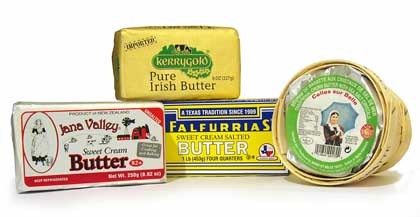A short course in European and domestic butters
Whether simply adorning a good cracker, smeared quickly on morning toast, or permeating an elaborate French dinner, butter has an undeniably decadent and primal hold on the imagination as well as the palate. Inherently rich and pleasurable, poetic allusions abound. In many of the world’s religious traditions and folk cultures, butter is a common symbol of abundance and prosperity. Vilified by contemporary fad diets and called on the carpet by some medical researchers, butter’s primal and enduring appeal is illustrated by the appearance of numerous domestic and imported options on grocery-store shelves. Curiosity may take its toll on the arteries and the pocketbook, but there’s no substitute for direct culinary experience any more than there is an acceptable substitute for butter. So, quite simply, we tried them.
| From the strong grass-fed flavor of Kerrygold to the delicate, smooth taste of Celles Sur Belle, a trip to the market to buy a stick of butter is a creamy adventure. Yet Diana Roberts cautions overly zealous gourmands that “the best butters aren’t the most expensive on the shelf.” |
A brief digression: I love butter, and am perfectly willing to indulge in subtleties of flavor and character. I’m also practical. Subtlety isn’t necessarily worth two or three times what one would ordinarily spend. As I suspected, some of the best butters aren’t the most expensive on the shelf. So, frugal gourmands, read on.
Experts have an elaborate range of terminology to describe various qualities of butter, just like wine aficionados. There are 120 chemical compounds that contribute to the unique taste of butter. The average palate isn’t quite that sophisticated, but there are some discernable differences to consider.
Butter is the product of milk or cream agitated until the fat solidifies and separates from the liquid. All commercial butters have a minimum of 80 percent milk fat from pure cream or milk, with approximately 18 percent water and 2 percent milk solids (mainly salts and other proteins). Most European and domestic “European-style” butters have a slightly higher fat content, usually 82-84 percent. Higher fat content means less water, which generally makes them preferable for baked goods and sauces. It is, after all, the fat that contributes the characteristic crustiness to baked goods and the smooth, gossamer sheen of a good sauce.
European-style butters are often “cultured,”meaning that bacterial cultures are added before churning to ferment the milk sugars (lactose), resulting in a richer, fuller taste. Cultured butter also has lower lactose content, which may be good news for those who are lactose intolerant.
For all the cachet of “European-style,” U.S. butter standards are quite high. An Act of Congress in 1923 forbid additives other than salt and coloring agents, and the USDA has a fairly rigorous grading system based on body, texture, flavor, aroma and appearance. Grade AA is the best, and is very high quality - fresh, sweet flavor and aroma with a consistent, smooth texture and good “spreadability.” Grade A is a close but less-refined second, and Grade B is typically used only for industrial purposes, with a less-than-fresh flavor and inferior texture.
Salt was originally added as a preservative before the days of refrigeration, but also contributes to butter’s rich flavor. Salt content may vary, which is why most baking recipes call for unsalted, but it’s an issue of taste. Butter keeps in the refrigerator for a month or more, and up to six months in the freezer.
Locally available butters fall into three general price categories: regular domestic ($2-4/lb), domestic organic or European style ($5-6/lb) and European import or artisanal domestic ($6-12/lb). The best selection of imports is at Central Market. Whole Foods and Sun Harvest tend toward domestic organics; other stores carry regular domestics.
We tried a variety of butters (see resources list, this page), and, frankly, all of them were good. But if one is going to splurge on expensive butter, it makes sense to use it well. Variations in flavor, texture and composition lend themselves to different uses. We picked a few of our favorites to subject each of these butters to.
The Kerrygold Irish has a strong, distinctive flavor, rich from the fresh grass pastures on which the cows feed. It also has a nice salty edge, perfect for spreading on crackers, bread, or scones. If you’re going to splurge on table butter, this is the one. The Lurpak Danish has a very similar quality, though less distinct and a bit milder.
The French President and Celles sur Belle butters are lighter and more delicate, both of them soft and smooth, lightly salted, almost like a mild cream. They make a rich foam when melted and throw lots of sediment — perfect for dipping sauces or beurre noir, where sediment is the point. These are also excellent spreading butters, and the mild flavor lends itself to blending with fresh herbs.
The Vermont Cultured Butter has a lovely flavor, which developed a deep, rich, nutty, pleasantly musty character atop boiled white rice — one of life’s simple pleasures. Its 86 percent fat content, with half the salt of regular butter, makes it an excellent choice for a sauté. But, considering the exceptionally high price tag, I expected more character across the board.
The Jana Valley is particularly neutral. It has little flavor as a table butter, little salt, and when melted it has almost no foam or sediment to burn. These characteristics make it a lovely butter for sautéing, enhancing other flavors and supplying an ultra-slippery cooking medium. This wallflower seemed always to pale in comparison until a startling discovery in the Shortbread Experiment. Not only did it provide an amazingly crisp, light texture but, somehow, the flavor positively sparkled, long after the crumbs had been devoured.
The Straus European Organic has a pleasant, mild flavor with a nice, oily texture. An excellent choice for baking, it’s a bit bland (and pricey) for general use. The price tag is consistent with other organics, so if it eases your conscience, go for it.
The subtle charm of exotic butter is certainly worth exploring. Yet, at less than half the cost of the others, the lower price Challenge and Falfurrias certainly held their own. For everyday use, the generally high quality of U.S. butter is something to consider. Everyday brands, including a few European-style and organic ones, are functional, delicious and might possibly be better for certain uses. If something special comes up, splurge by all means. Finding the subtle characteristics of any ingredient, and how it mingles with others, is the key to any culinary success. •
For a list of butter-related websites, please visit sacurrent.com
| Resources: where to buy the butter | |||
| BRAND | ORIGIN | WHERE TO BUY | COST |
| Challenge Butter | California | La Fiesta | $3/lb |
| Falfurrias | Texas | H-E-B / Central Market / La Fiesta | $3.59/lb |
| Straus European Style Organic | California | Whole Foods | $5.69/lb |
| President | France | Central Market | $1.99/7oz |
| Celles sur Belle | France | Central Market | $5.99/8.8oz |
| Lurpak | Denmark | Central Market | $3.69/8.8oz |
| Jana Valley | New Zealand | Central Market | $2.99/8.8oz |
| Kerrygold | Irish | Central Market | $3/8.8oz |
| Vermont Butter & Cheese Company Cultured Butter | Vermont | Central Market | $4.29/8oz |


















